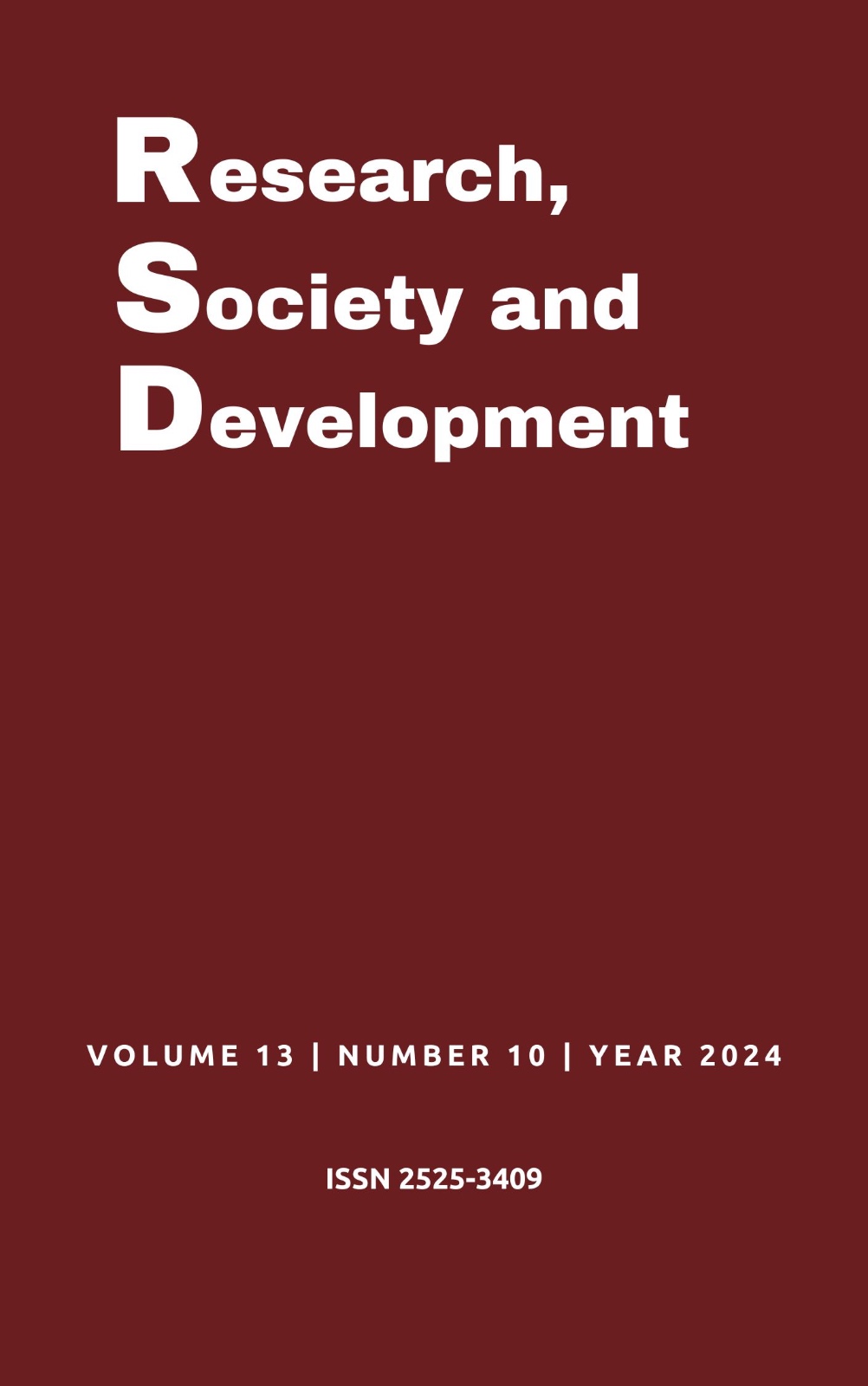Factors associated with molar incisor hypomineralization: A literature review
DOI:
https://doi.org/10.33448/rsd-v13i10.46895Keywords:
Molar hypomineralization, Dental enamel, Dentistry.Abstract
Objective: to analyze the factors associated with molar-incisor hypomineralization in children. Methodology: this is an integrative literature review study with a qualitative approach. For the review, the health databases available in the Scientific Electronic Library Online (SciELO), in the Latin American and Caribbean Health Literature (LILACS) database accessed through the Virtual Health Library (VHL) and in the PubMed database were used. Results: The study identified that molar-incisor hypomineralization is defined as a qualitative development defect of the dental enamel, which necessarily affects one or more permanent molars, but which may or may not involve the incisors. Thus, the structural conditions of the teeth affected by MIH imply in recurring needs for dental treatments and cause biopsychosocial, emotional and aesthetic impacts on the patients' quality of life. Conclusion: It is concluded that knowledge of the etiological factors can contribute to the identification of children who are more prone to this condition, as well as the establishment of preventive measures, with the aim of avoiding or reducing the possibility of manifestation of the consequences of this enamel defect.
References
Araújo, G. V. C., Santos, N. S., & Romeiro, A. P. S. (2021). Hipomineralização molar-incisivo (HMI): fatores etiológicos – uma revisão de literatura. Brazilian Journal of Health Review, 4(6), 26173-26184.
Bassetti, A. C., et al. (2020). Condições de saúde bucal e prevalência de hipomineralização molar-incisivo (HMI) em pacientes autistas: estudo piloto. RSBO, 17(1), 55-6.
Bezamat, M., et al. (2021). Gene-environment interaction in molar-incisor hypomineralization. PLoS ONE, 16(1), 0241898.
Butera, A., et al. (2021). Assessment of Genetical, Pre, Peri and Post Natal Risk Factors of Deciduous Molar Hypomineralization (DMH), Hypomineralized Second Primary Molar (HSPM) and Molar Incisor Hypomineralization (MIH): A Narrative Review. Children, 8(432), 1-12.
Cabral, R. N. (2017). Novo sistema de detecção para a hipomineralização molar incisivo: diagnóstico, progressão dos defeitos e decisão de tratamento. 131 f., il. Tese (Doutorado em Ciências da Saúde) — Universidade de Brasília. Brasília.
Coelho, A. S. E. C., et al. (2018). Dental hypomineralization treatment: A systematic review. J Esthet Restor Dent, 31(1), 26-39.
Domingos, P. A. S., et al. (2019). Hipomineralização MolarIncisivo: revisão de literatura. Journal of Research in Dentistry, 7(1), 8-12.
Eller, J. C. M. S., et al. (2021). Hipomineralização Molar Incisivo: Desafios Clínicos e Tratamento em Odontopediatria. Revista FIMCA, 8(1), 47-50.
Fragelli, C., et al. (2021). Aesthetic perception in children with molar incisor hypomineralization. European Archives of Paediatric, 22, 227–234.
Garot, E., et al. (2021). An update of the aetiological factors involved in molar incisor hipomineralisation (HMI): a systematic review and meta-analysis. Eur. Arch. Paeditr Dent., 23(1), 23-38.
Gil, A. C. Como Elaborar Projetos de Pesquisa. 4. ed. São Paulo: Atlas, 2009.
Goursand, D., et al. (2023). Conhecendo a hipomineralização molar-incisivo: do diagnóstico ao tratamento. Brazilian Journal of Health Review, 6(1), 1016-1024.
Juárez-López, M. L., et al. (2023). Etiological Factors of Molar Incisor Hypomineralization: A Systematic Review and Meta-Analysis. Dent. J, 11(111), 2-16.
Kilinç, G., et al. (2019). Prevalence, aetiology, and treatment of molar incisor hypomineralization in children living in Izmir City (Turkey). Int J Paediatr Dent, 29(6), 775-782.
Marinho, R. B. V., Vasconcelos, R. B., & Aguiar, L. P. (2024). Conhecimento dos acadêmicos acerca do diagnóstico e tratamento precoce da HMI na infância. Archives of Health, 5(1), 220-246.
Mendes, K. D. S., Silveira, R. C. C. P., & Galvão, C. M. (2008). Revisão integrativa: método de pesquisa para a incorporação de evidências na saúde e na enfermagem. Texto Contexto Enferm, 17(4), 758-64.
Neves, A. B., et al. (2019). Breakdown of demarcated opacities related to molar-incisor hypomineralization: a longitudinal study. Clinical Oral Investigations, 23(2), 611-5.
Pereira, M. S. S., et al. (2021). Hipomineralização molar-incisivo: um desafio na rotina da odontopediatria do Século XXI. RvAcBO, 10(2), 80-86.
Resende, P. F., Favretto, C. O. (2019). Desafios clínicos no tratamento de hipomineralização molar incisivo. Journal of Oral Investigations, 8(2), 73-83.
Silva, T. C. P. et al. (2022). Hipomineralização Molar-Incisivo – Um relato de caso clínico. RECISATEC – Revista Científica Saúde e Tecnologia, 2(12), 1-13.
Souza, M. T., Silva, M. D., & Carvalho, R. (2010). Integrative review: what is it? How to do it? Einstein, 8(1) 102-6.
Vieira, L. D. S., et al. (2019). Antimicrobial photodynamic therapy on teeth with molar incisor hypomineralization-controlled clinical trial. Med (United States), 98(39), 1-7.
Vieira, P. R., et al. (2018). Qualidade de vida e percepção estética da cárie dentária. Rev Bras Promoç Saúde, 31(1), 1-9.
Wu, X., et al. (2018). Association of molar incisor hypomineralization with premature birth or low birth weight: systematic review and meta-analysis. J. Matern. Fetal Neonatal Med, 33(10), 1700-1708.
Downloads
Published
Issue
Section
License
Copyright (c) 2024 Aurilene Oliveira Torres; Pedro Fideles Neto; Tainá de Castelo Branco Araújo; Isabel Cristina Quaresma Rêgo; Lilian Gomes Soares Pires

This work is licensed under a Creative Commons Attribution 4.0 International License.
Authors who publish with this journal agree to the following terms:
1) Authors retain copyright and grant the journal right of first publication with the work simultaneously licensed under a Creative Commons Attribution License that allows others to share the work with an acknowledgement of the work's authorship and initial publication in this journal.
2) Authors are able to enter into separate, additional contractual arrangements for the non-exclusive distribution of the journal's published version of the work (e.g., post it to an institutional repository or publish it in a book), with an acknowledgement of its initial publication in this journal.
3) Authors are permitted and encouraged to post their work online (e.g., in institutional repositories or on their website) prior to and during the submission process, as it can lead to productive exchanges, as well as earlier and greater citation of published work.


